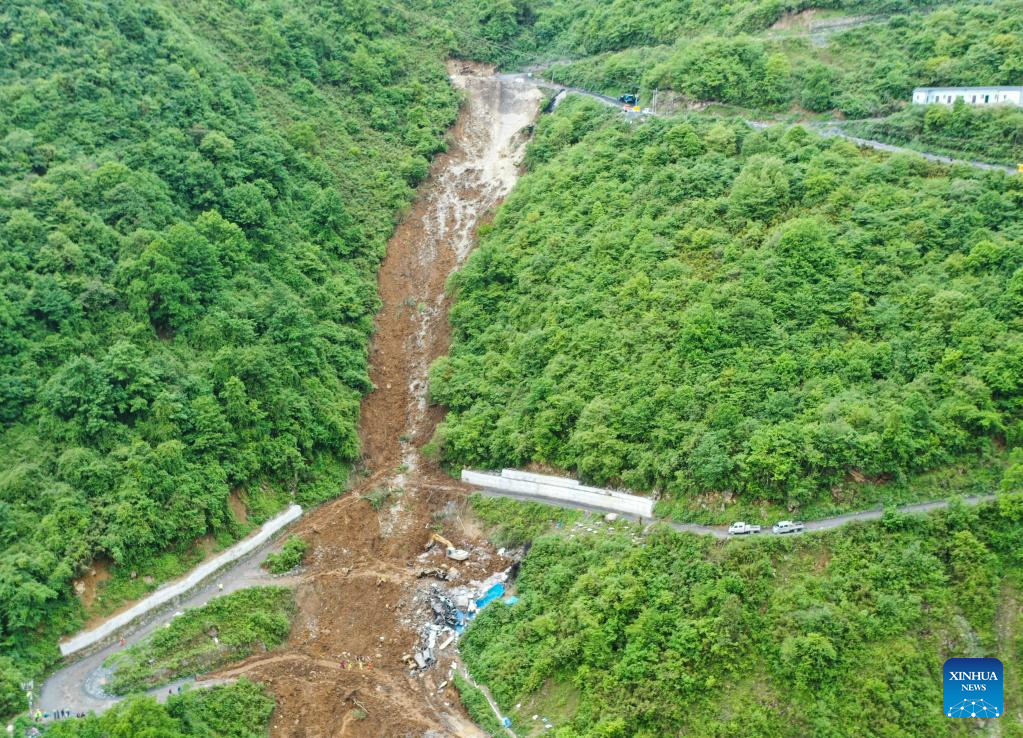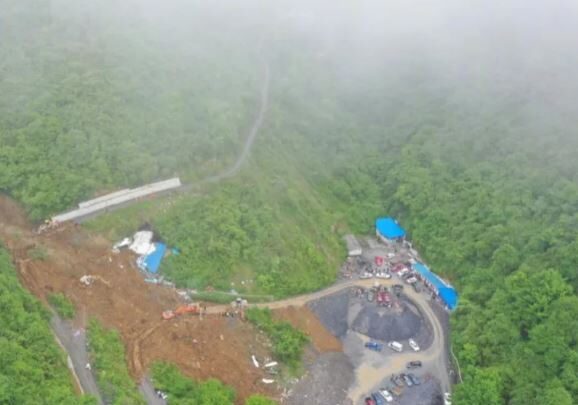6 June 2023
The 4 June 2023 landslide at Yongsheng Township in Sichuan Province, China
Posted by Dave Petley
The 4 June 2023 landslide at Yongsheng Township in Sichuan Province, China
On 4 June 2023 a fatal landslide occurred at Yongsheng Township in Jinkouhe District, part of the area administered by Leshan City in Sichuan Province in China. The landslide struck the dormitory of a phosphorite mine, killing 19 people. Rescue and recovery operations have concluded.
Xinhua News has released this image of the site:-

The 4 June 2023 landslide at Yongsheng Township in Sichuan Province, China. Image via Xinhua News.
.
Yongsheng appears to be located at [29.369, 103.065], although this is unconfirmed and I have not tied down the precise location of the landslide itself.
The landslide itself is interesting. It appears to be to be a failure in a gentle gully, probably initiated at the crown of the landslide scar but then entraining a large volume of material downslope. The location of a destroyed structure is visible, alongside a backhoe.
Note that the crown is located on a hairpin bend on the road, with a small cut visible too. It is hard to believe that this landslide is not associated with the road; a working hypothesis might be that a fill slope was created on the downslope side of the hairpin bend, possibly with material from the road cut, to widen the road at this point, allowing vehicles to swing around the corner. This fill material might then have failed, loading the slope and progressively driving a larger failure. That fill is present is potentially supported by the fine-grained, grey material visible in the upper part of the landslide scar.
Yahoo News also has an image of the site, taken from another angle:

The lower part of the 4 June 2023 landslide at Yongsheng Township in Sichuan Province, China. Image via CCTV / Yahoo News.
.
The grey area on the right of the image is reported to be the platform of the mine being developed by Jinkaiyuan Mining Company. Heavy rainfall was reported at the time of the landslide, which injured seven people in addition to the 19 fatalities. This is the early part of the rainy season in China, when most landslides occur.


 Dave Petley is the Vice-Chancellor of the University of Hull in the United Kingdom. His blog provides commentary and analysis of landslide events occurring worldwide, including the landslides themselves, latest research, and conferences and meetings.
Dave Petley is the Vice-Chancellor of the University of Hull in the United Kingdom. His blog provides commentary and analysis of landslide events occurring worldwide, including the landslides themselves, latest research, and conferences and meetings.
The initiation of the slide on the road at the headscarp looks very similar to that from logging roads in the Pacific Northwest. Cut and fill dumped on the downhill gully slope. It is less common here now following regulations.
I spent 25 years on timber haul roads of the Klamath Mountains, California. A side-cast fill in the hairpin (switchback) curve would be rather large to pass a low-boy, low-bed, goose-neck trailer, for moving such as a hydraulic excavator. I don’t see the corrugated metal pipe that might pass the water under such a fill in this gully. Such culverts are also prone to debris plugs, ponding water behind the fill and over topping to flow across the fill. The fill might be built of mine-waste, overburden, mill tailings, plenty of that at a mine site. Unsurfaced roads in heavy rain can be very muddy, the immediate solution being side-cast the mud with a blade and/or spreading coarse crushed rock on the road.
But I haven’t found this site in Google Earth, wanting for more information…
It appears the valley continues upslope above the hairpin curve which certainly brings runoff. What I don’t see in the image, is a convanence culvert for runoff water. If the roadway cut and fill created a larger damn in the curve, where originally floodwaters spilled over this would cause intense soil saturation if the culvert clogged. Just guessing.
I agree with Nigel. Road drainage and poor fill most likely an issue. Sometimes we recommended backdrains in order to intercept observed high ground water in colluvial soils along specific swales. Water can be trapped behind a well-compacted fill, inadvertently turning it into a “subsurface dam”.
Cost-Effective stabilization of low-volume roads. My favorite, crib wall of used tires.
Transportation Research Board, 2012, National Cooperative Highway Research Program (NCHRP) Synthesis 430: Cost-Effective and Sustainable Road Slope Stabilization and Erosion Control presents information on cost-effective and sustainable road slope stabilization techniques, with a focus on shallow or near-surface slope stabilization and related erosion control methods used on low-volume roads.
https://nap.nationalacademies.org/catalog/22776/cost-effective-and-sustainable-road-slope-stabilization-and-erosion-control
DESIGN OF SUBSURFACE DRAINAGE SYSTEMS FOR CONTROL OF GROUNDWATER. L. K. Moulton, 1979, Transportation Research Record.
https://www.semanticscholar.org/paper/DESIGN-OF-SUBSURFACE-DRAINAGE-SYSTEMS-FOR-CONTROL-Moulton/8b11c156fd82bc23393775887a559ff17a0c5e0a